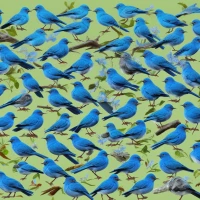Visual feast where the beaks blaze brighter than the sunset! In Birds with Orange Beaks : Discover the Vibrant Avian Wonders, we’re diving beak-first into the world of feathered friends that boast an irresistible dash of tangerine charm. Join us as we uncover a dozen feathered phenoms that carry the kiss of citrus on their beaks, making them the envy of the avian kingdom.
From backyards to distant shores, these colorful critters are waiting to wing into your heart and imagination. Prepare to be dazzled by nature’s palette – after all, who knew orange could be the new black of the bird world?
1. Northern Cardinal

The Northern Cardinal is a medium-sized songbird with a distinctive crest, known for the male’s bright red plumage and sweet whistles, commonly found in North America’s woodlands and backyards.
2. Common Blackbird

The Common blackbird (Turdus merula) is a widespread species in Europe, identifiable by its all-black plumage in males and brownish females, with a distinctive orange beak and eye-ring in both sexes. They are omnivorous and known for melodic songs.
3. Atlantic Puffin

The Atlantic puffin is a seabird known for its colorful beak, black and white plumage, and adept swimming ability. It breeds in large colonies on north Atlantic coastlines and islands.
4. Toco Toucan

The Toco toucan is a large, colorful South American bird with a distinctive long, orange bill and vibrant plumage. They feed on fruit, insects, and occasionally small animals, and are known for their playful and social behavior.
5. Oystercatchers

Oystercatchers are wading birds known for their long, stout bills and loud calls, commonly found along coastlines where they feed on shellfish, which they expertly open with their specialized bills. They exhibit striking black and white plumage.
6. Malachite Kingfisher

The Malachite Kingfisher (Corythornis cristatus) is a small, vibrant waterbird with a blue-green crest found across sub-Saharan Africa, inhabiting rivers and wetlands, recognized by its colorful plumage and darting flight while hunting for fish.
7. Rainbow Lorikeet

The Rainbow Lorikeet is a vibrantly colored parrot found in Australia, known for its red beak and a rainbow of plumage, including blue head, green wings, and orange chest, and for its brush-tipped tongue to feed on nectar.
8. Crowned Hornbill

The Crowned Hornbill is an African bird known for its striking casque-topped beak, it feeds on insects and fruit, and exhibits dramatic courtship displays, often found in forests and woodlands across sub-Saharan Africa.
9. Oropendola

The Oropendola is a tropical Central and South American bird known for its striking plumage and unique, hanging woven nests. They belong to the family Icteridae and are notable for their vibrant calls and complex social structure.
10. Bank Myna

The Bank Myna (Acridotheres ginginianus) is a myna species native to South Asia, known for its association with riverbanks and human habitats. It has a brown body, grey head, and distinctive yellow skin patch behind the eye.
11. Fieldfare

The Fieldfare (Turdus pilaris) is a member of the thrush family, known for its striking plumage with grey head, chestnut back, and spotted underparts. It breeds in woodland and scrub in Europe and Asia, wintering in southern Europe and North Africa.
12. Royal Tern

The Royal Tern (Thalasseus maximus) is a seabird known for its large size, sleek profile, and orange-red bill. It inhabits coasts and estuaries in North and South America and favors fish-based diets, often diving to capture prey.
Conclusion Birds with Orange Beaks
Birds with orange beaks represent a diverse group of avian species, each with unique behaviors, habitats, and roles in their ecosystems. The color of a bird’s beak is often a product of genetic factors, diet, and possibly even environmental influences. The orange hue seen in the beaks of certain birds can serve multiple purposes, such as attracting mates during breeding seasons, signaling health and vitality, and could also be a result of carotenoid pigmentation, which can be obtained from their diet.
Some well-known bird species with orange beaks include:
- American Oystercatcher - This shorebird has a distinctive long, bright orange beak which it uses to pry open shellfish.
- Atlantic Puffin - The puffin’s beak is famous for its colorful palette during the breeding season, with orange being a prominent component.
- Black Skimmer - With a unique beak where the lower mandible is longer than the upper one, the black skimmer’s orange beak is a tool for fishing by skimming it over the water.
- Northern Cardinal - The male of the species sports a bright orange beak that contrasts with its vivid red plumage.
- Toco Toucan - Known for its large, striking beak, the toco toucan has a mostly orange beak with a black tip and blue around the base.
In conclusion, birds with orange beaks are found across various families and orders, and their vibrant beaks serve as an example of the vast array of adaptations and characteristics that birds have evolved. Whether for foraging, mating displays, species recognition, or other uses, the orange beak is just one of many features that highlight the incredible diversity and complexity of the avian world.










